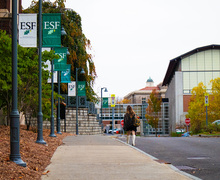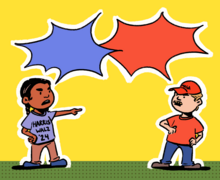How Ange Bradley revamped SU’s program 5 years after winning NCAA title
Daily Orange File Photo
Ange Bradley led Syracuse field hockey to 11 NCAA Tournament appearances. Five years after the national title, former players speak on Bradley’s impact.
The Daily Orange is a nonprofit newsroom that receives no funding from Syracuse University. Consider donating today to support our mission.
Heather Hess still remembers Syracuse’s 2008 warm-up jerseys. The number 59 flashing on the backs of her teammates during practice served as a constant, vivid reminder of how few goals they’d scored the season before.
It was an idea Ange Bradley implemented after her first season as the Orange’s head coach. She’d arrived in December 2006 after six years at Richmond, inheriting a 10-9 Syracuse team.
Rather than calling out players, Bradley created an atmosphere where teammates held each other accountable, Hess said. Those warmups motivated them to work harder, as SU more than doubled its offensive output that season.
Nine years after Bradley took over and five years ago this year, Syracuse field hockey became the first women’s program to win a national title. Bradley changed the program from a three-time NCAA Tournament attendee since 1982 to a yearly contender and ranked Atlantic Coast Conference member. After having only a couple of seasons over .500 since 2001, Syracuse went 12-7 in Bradley’s first year and has missed the NCAA tournament just once since 2008.
“From the moment I met Ange, I knew I was going to be uncomfortable,” Heather Doran said, a player from 2005-8. “And I remember thinking that I’ve never seen a more driven person in my life.”
• • •
Gloria Nantulya, who played from 2004-7, was surprised at Bradley’s expectations for Syracuse. When the new head coach arrived, Bradley called Syracuse a “sleeping giant.”
Under Kathleen Parker, the Orange’s previous head coach, the goal was to win the Big East. Players knew who was going to fill starting roles the next season as early as spring practices, and fitness workouts consisted of a few sprints or a couple of laps.
But under Bradley, playing time based on seniority vanished. She regularly ran players around a Manley Field House indoor track and started handing out spreadsheets detailing when players would get on the bus, stop for lunch and arrive at the locker room during road trips. Those spreadsheets even told players what to put in their meal plan, said Regan Spencer, a player from 2013-16.
If Syracuse tried on new sweatshirts, Bradley made sure her players folded the clothes before the equipment team picked them up. And Bradley always made sure the locker room was clean, because that contributed to a “championship mentality,” Spencer said.
“I remember her saying that, you know, if we didn’t have the skill to beat somebody, we were certainly going to outrun them,” Doran said. “And we did.”
After Bradley arrived, the field hockey team began running more than the track team, track athletes told Nantulya. Bradley gave each player personal times to meet, rather than giving the team a collective time, like Parker did. But during one 2008 spring practice, Bradley assigned players a running time that was slower than usual. A lot slower.
Doran remembered teammates looking at each other, confused. Once they finished the run, Bradley told them those times were the first ones they ran that season.

Ange Bradley led the Syracuse field hockey team to a national championship title in 2015. Daily Orange File Photo
Mondays were off-days, and players ran the most on “terrible Tuesdays,” Nantuyla said. And at least once a week, Syracuse had a “mental toughness day,” Spencer said. The number of mental toughness days varied per week, depending on the team’s schedule. When practice ended and players had already run 10, 100-meter sprints, Bradley told them that the “game” had gone to overtime. Then, everyone ran three more 100-meter sprints, meeting an individual time.
Years later, Nantulya asked a teammate how those practices compared to giving birth.
“I don’t know, they’re about the same,” Nantulya remembered her former teammate saying.
In Bradley’s inaugural season, Syracuse started 5-0 for the first time in a decade and was nationally ranked. Media members wanted to interview players about the remarkable turnaround of the program, but Bradley wouldn’t allow any interviews.
“We have to stay focused,” Bradley said.
Bradley set objectives for each game, depending on the opponent. In 2007, Syracuse hadn’t beat Connecticut in six years. Bradley set a team goal to limit the Huskies to five penalty corners, where they had previously generated plenty of chances.
“Whenever we played UConn, it almost became like the game that you walk into and you expect to lose,” Nantulya said.
The game began at 1 p.m., and by 1:25, forward Lauren Aird had scored twice for the Huskies. Eventually, UConn won 5-2 in the most competitive match Nantulya had ever played against the Huskies.
After the game, Nantulya glanced at the scoreboard. UConn had one penalty corner.
• • •
Jordan Page didn’t step foot on Syracuse’s campus as a student until 2011, despite being committed to SU for two years. After a visit to another school, she called Bradley and told the head coach she wanted to help her win the program’s first national championship.
In 2012, Page’s sophomore season, Syracuse made it back to the final four for the second time under Bradley. The first had come one year after the 2007 regular-season loss to the Huskies.
SU faced the Huskies again that year, in the Big East semifinals. The team stayed competitive but ultimately lost again on their home field, this time to end its season. Bradley gathered her team and said they’d watch the championship game between Princeton and UConn the next day. There, she told the Orange that they’d defeat UConn in Storrs next season for the Big East title.
“That was very tough, to go out there and watch that game,” Doran said. “But I remember her saying that, and I remember thinking she was right. And had that not been Ange saying those words, I probably wouldn’t have thought that that would have been achievable.”
Bradley and Syracuse inched toward that point with 14-straight wins to open the 2008 season. In the 15th game, they lost to No. 9 UConn 1-0 at J.S. Coyne Stadium, Syracuse’s ninth consecutive defeat to UConn. But the teams met again in the Big East championship.
After 70 scoreless minutes, with UConn tripling SU’s shots, Syracuse had a penalty corner. Lindsey Conrad passed the ball to back Maggie Befort, and the sophomore tipped the ball in, clinching the Big East Championship for SU.
“I sprinted down to the other end of the field,” Hess, the goalkeeper, said. “(Conrad) had made the comment to me. She was like, ‘Yeah I was going to come meet you. And I looked down and you were gone. And all of a sudden, you’re up here. That’s the fastest you’ve ever ran.’”

Katelyn Marcy | Digital Design Director
Syracuse ultimately fell to Wake Forest in the final four, but two years later, the team made the championship game. By 2012, Syracuse had defeated the Huskies at least once for the last four consecutive years, and Bradley was no longer playing with athletes recruited by Parker.
“She really recruits athletes,” said Jamie Martin, who played from 2015-18. “She looks for people who maybe don’t necessarily have the accolades in high school, but they have the will to win, and they have that aggressive athletic build.”
Syracuse switched over to the ACC after Page’s first two seasons, and the Orange played top 10 teams every week, Page said. After defeating No. 1 UNC in the 2014 national semifinals, Syracuse faced UConn, once again, in the program’s first NCAA Championship game.
As Syracuse walked off the bus in College Park, Maryland for the championship game, Bradley stopped Page.
“Do you remember what you told me when you committed to come here?” Bradley asked. Page did.
But the Huskies scored first once the game began. That first half goal turned into the only score of the game, and Syracuse was again eliminated by UConn.
After losing in 2014, the team was “laser focus,” Martin said. Over offseason practices, players held each other to high standards, which had become the norm. “You’re playing Maryland right now,” Bradley would commonly yell in practice over the years, Doran said. “You’re playing UConn!”
“It was never an option, like we were going to make it back there,” said Caroline Cady, a player from 2014-18. “We are going to get back there, and that was our mindset from the beginning, when we lost that game.”
The 2015 squad was also one of the most talented in program history. Goalkeeper Jess Jecko was selected to the U.S. National Team after graduating. Midfielder Alyssa Manley was selected to the U.S. Olympic roster, and midfielder Alma Fenne earned First Team All-American with 47 points, the sixth most in one season in program history. Forward Emma Russell finished her career as Syracuse’s all-time leader in points (140) and goals (57). All four were seniors.
“I remember coming in preseason in 2015 and helping out a bit and I said to Ange like, ‘I think you’re gonna do it,’” said Page, who graduated in 2014.
Syracuse went undefeated in the regular season and won its first three NCAA tournament games by a score of 12-3, reaching the title game against the Tar Heels.
Russell scored first in the ninth minute before Fenne extended the lead nine minutes later. But after the early lead, the Tar Heels scored twice to tie the game in the 59th minute.
One of Bradley’s objectives in every game is to enter the opponents’ inner circle within two minutes after a player has scored on. Less than three minutes later, SU’s Zoe Wilson scored the first goal of her career. Then, Emma Lamison tacked on the fourth SU goal, and the Orange won 4-2.
“I’ve been chasing this dream for 25 years,” Bradley said postgame.
Almost a decade after taking over the Syracuse program, after years of sprints, spreadsheets and mediocre scoring numbers on the backs of jerseys, Bradley and SU field hockey had won SU’s first women’s national championship.
“When they won it in 2015, it was just like all of us were celebrating,” Nantulya said. “We had seen the journey from where it was when she had first come in to where it is now.”
Sports editor Andrew Crane contributed reporting to this story.
Published on October 28, 2020 at 11:07 pm
Contact Thomas: tgshults@syr.edu | @ThomasShults_






